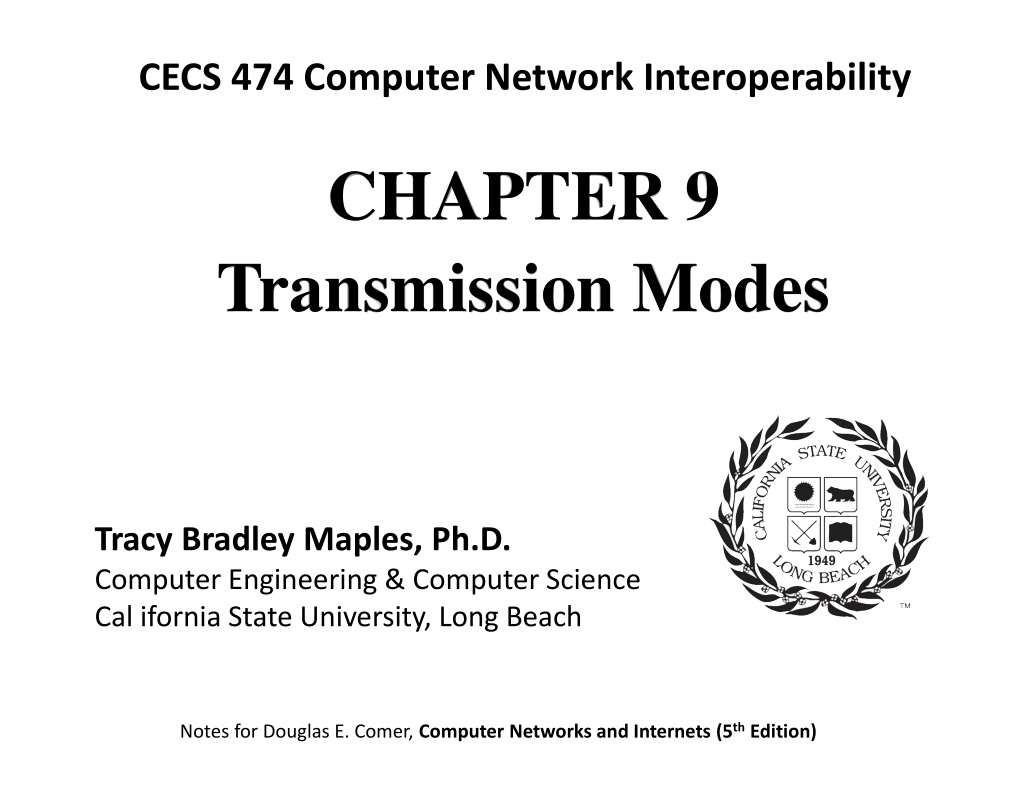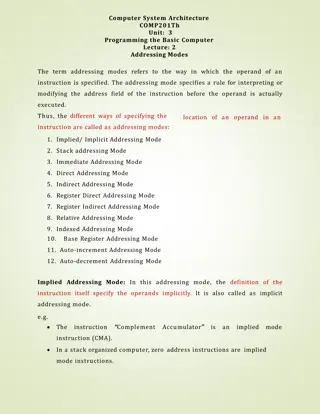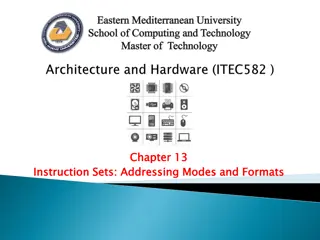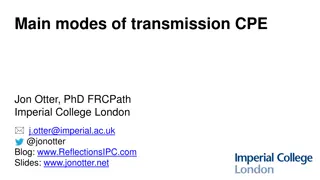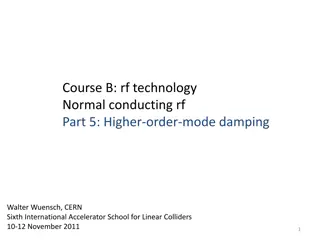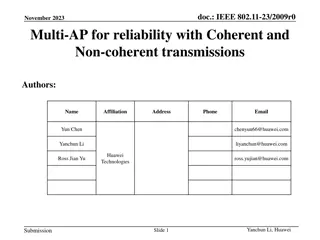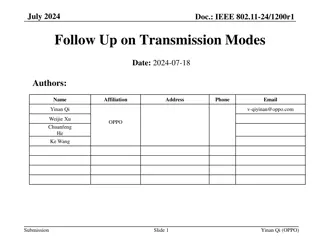Understanding Transmission Modes in Computer Networks
Transmission modes in computer networks can be divided into serial and parallel modes. Parallel transmission allows multiple bits to be sent simultaneously over separate media, while serial transmission sends one bit at a time. The choice between serial and parallel transmission depends on factors such as speed, distance, and cost. Additionally, considerations like bit and byte order, little-endian vs. big-endian systems, and synchronization play a crucial role in data transmission efficiency.
Download Presentation

Please find below an Image/Link to download the presentation.
The content on the website is provided AS IS for your information and personal use only. It may not be sold, licensed, or shared on other websites without obtaining consent from the author. Download presentation by click this link. If you encounter any issues during the download, it is possible that the publisher has removed the file from their server.
E N D
Presentation Transcript
CECS 474 Computer Network Interoperability CHAPTER 9 Transmission Modes Tracy Bradley Maples, Ph.D. Computer Engineering & Computer Science Cal ifornia State University, Long Beach Notes for Douglas E. Comer, Computer Networks and Internets (5th Edition)
A Taxonomy of Transmission Modes Defn: A transmission mode is the manner in which data is sent over the underlying medium Transmission modes can be divided into two fundamental categories: Serial one bit is sent at a time Parallel multiple bits are sent at the same time ?
Parallel Transmission Parallel transmission allows transfers of multiple data bits at the same time over separate media. It is used with a wired medium The signals on all wires are synchronized so that a bit travels across each of the wires at precisely the same time The figure omits two important details: 1. a parallel interface usually contains other wires that allow the sender and receiver to coordinate 2. to make installation and troubleshooting easy, the wires are placed in a single physical cable A parallel mode of transmission has two chief advantages: (1) High speed--it can send N bits at the same time. (2) It can match the speed of the underlying hardware. ?
Serial Transmission Serial transmission sends one bit at a time. Most communication systems use serial mode, because: serial networks can be extended over long distances at less cost using only one physical wire means that there is never a timing problem caused by one wire being slightly longer than another ? Sender and receiver must contain a hardware that converts data from the parallel form used in the device to the serial form used on the wire
Transmission Order: Bits and Bytes In serial mode, when sending bits, which bit should be sent across the medium first? Consider an integer: Should a sender transmit the Most Significant Bit (MSB) first? the Least Significant Bit (LSB) first? Terminology: little-endian describes a system that sends the LSB first. big-endian describes a system that sends the MSB first . Either form can be used, but the sender and receiver must agree.
Transmission Order: Bits and Bytes (contd) Additionally, the order the bytes are sent must be determined. Data in a computer is divided into bytes, and each byte is further divided into bits (typically 8 bits per byte) Thus, it is possible to choose a byte order and a bit order independently For example, Ethernet specifies that data is sent byte big-endian and bit little-endian ?
Timing of Serial Transmission Serial transmission mechanisms can be divided into three broad categories (depending on how transmissions are spaced in time): Asynchronous transmission can occur at any time Synchronous transmission occurs continuously Isochronous transmission occurs at regular intervals
Asynchronous Transmission Asynchronous transmission allows the physical medium to be idle for an arbitrary amount of time between two transmissions. It is well-suited to applications that generate data at random time intervals. For example: a user typing on a keyboard a user that clicks on a hyperlink Asynchronous disadvantage: While the medium is idle, a receiver cannot know how long the medium will remain idle before more data arrives. Asynchronous technologies usually require the sender to transmit a few extra bits before each data item: to inform the receiver that a data transfer is starting extra bits (preamble or start bits) allow the receiver to synchronize with the incoming signal
Example:RS-232 Asynchronous Character Transmission Before USB, RS-232-C is the most widely accepted way to transfer characters across copper wires between a computer and a device such as a modem, keyboard, or terminal. RS-232 defines serial, asynchronous communication. RS-232 specifies the physical connection as well as the electrical details: Specified by the EIA Voltage is +15 or 15 volts Cable limited to ~50 feet Latest EIA standard is RS-422 (ITU standard is V.24) It specifies the transfer of characters (usually 7-bit) Example use: connection to a keyboard or mouse via the serial port on a PC
Example:RS-232 Asynchronous Character Transmission (contd) For RS-232 to work asynchronously: Sender and receiver must agree on Number of bits per character Duration of each bit Receiver Does not know when a character will arrive May wait forever To ensure meaningful exchange send: Start bit before each character One or more stop bits after each character Start bit Same as 0 Not part of data Stop bit Same as 1 Follows data ? Figure 5.2 Voltage on a wire as a character is transmitted using RS-232.
Baud Rate, Framing and Errors The duration of a bit in RS-232 is determined by the baud rate. Defn: The baud rate of transmission hardware is the number of changes in the signal per second that the hardware generates. Example: Typical baud rates: 9.6 Kbaud, 14.4 Kbaud and 28.8 Kbaud For RS-232 (it is a very simple scheme), the baud rate is exactly equal to the number of bits per second. Example: 28.8 Kbaud = 28.8 kbits per second The duration of a bit = 1/(baud rate) To make RS-232 more general, manufacturers design each piece of hardware to operate at a variety of baud rates. Sender and receiver must agree on the baud rate Receiver samples the signal to verify agreement Disagreement results in a framing error
Isochronous Transmission Isochronous transmission is designed to provide steady bit flow for multimedia applications. Isochronous networks are designed to accept and send data at a fixed rate, R. This is ideal when delivering such data at a steady rate is essential (jitteris minimized). Network interface is set to transmit/receive exactly R bits per second Example: An isochronous mechanism designed to transfer voice operates at a rate of 64,000 bps: A sender must generate digitized audio continuously A receiver must be able to accept and play the stream at 64,000 bps
Simplex, Half-Duplex, and Full-Duplex Transmission A communications channel can be classified as one of three types: 1. Simplex: A simplex mechanism can only transfer data in a single direction. It is analogous to broadcast radio or television 2. Full-Duplex: Full-duplex allows transmission in two directions simultaneously. 3. Half-Duplex: A half-duplex mechanism involves a shared trans- mission medium. The shared medium can be used for communication in each direction but the communication cannot proceed simultaneously. ?
